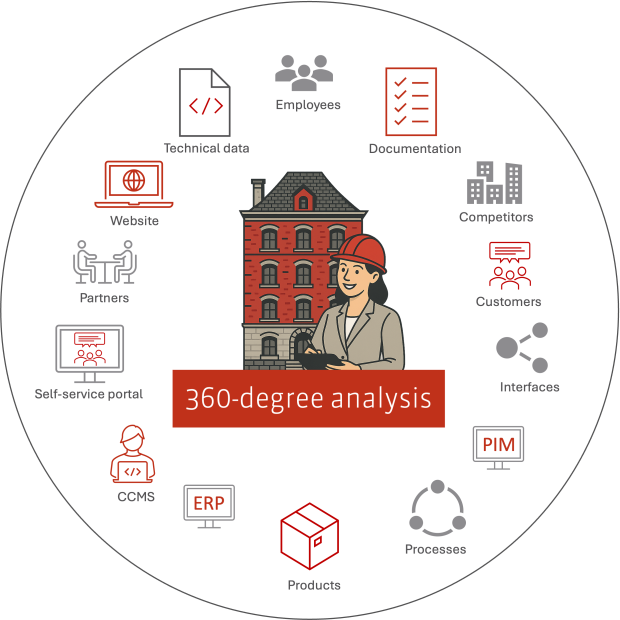Why companies benefit from a 360-degree analysis of their content and processes
Are you ready to review your business processes and content?
Every day, companies publish numerous pieces of content, including data sheets, website articles, knowledge articles, support information and operating instructions. The structure of corporate content often is the result of organic growth over time. Imagine a solid house that has been expanded and modernized over the years. While house remains stable and serves its purpose, some of its features may be outdated. Yet, underlying structures may have developed that go unnoticed in daily operations but eventually impact smooth workflows.
Similar to renovating or extending a house – adding new pipes, wiring, and connections behind the walls , for example – companies accumulate processes, interfaces, and responsibilities over time.

While this can enhance performance, it may also lead to overlapping workflows, duplicate content maintenance, and delayed coordination. These challenges are especially apparent in technical communication and product data management:
- Approvals take time because even minor changes require a full review of the document.
- The same data is stored in multiple systems, including development databases and component content management systems (CCMS).
- Information is passed to other departments through meetings and manually maintained documents.
- Each department only sees its own segment and has its own understanding of the company’s product structure.
- Inefficiencies, duplicate work, and unclear roles often go unnoticed until a digitalization project stalls or customers become dissatisfied.
Time for a 360-degree analysis: the view from outside and from all perspectives
This is where the 360-degree analysis comes in. It’s like a thorough building inspection – but for content, processes, and data flows. Rather than checking just one room, the 360-degree analysis looks at the entire "house."
- from the perspective of the employees who work with it daily
- from the perspective of management pursuing strategic goals
- from the perspective of customers and external partners who experience the outcomes
The result is an interconnected, realistic picture. It reveals where processes are stuck and where unnecessary detours arise. It also shows how to eliminate these issues.
This analysis is often the first step in a transformation process. It identifies areas for optimization that the company then prioritizes before beginning the actual "construction work".
More than just a process check
The 360-degree analysis is not just a box-ticking audit. It’s a tool that creates clarity. It helps:
- Prepare digitalization initiatives, such as a new CCMS, customer platform, chatbot for customer service, or digital twin
- Streamline existing processes to avoid duplicate work and optimize interfaces
- Improve collaboration by overcoming departmental and system boundaries
Because so many areas and tools are interconnected, it is beneficial to look beyond your own department.
From theory to practice: successful 360-degree analysis examples
The underlying causes of process inefficiencies and a lack of customer-facing information tend to be similar. For example, many companies have poorly connected data silos. Others still rely on static documents instead of modular content, making it difficult to supply digital channels, such as self-help portals or chatbots. Additionally, many companies have numerous delivery channels, forcing users to search multiple sites and documents for the right information.
However, the areas identified during the analysis that will become future construction projects vary by company. This is because priorities depend on a company’s modernization goals and digitalization strategy. For example, one company may prioritize automating technical documentation by generating data sheets directly from product data. Another company may prioritize creating a customer platform that provides product information and technical documentation through a single digital channel to boost online visibility.
Below are some of our projects in this area:
Digitalization of technical documentation and introduction of self-customer service at SEEBURGER
SEEBURGER planned to modernize and digitize its learning materials. The goal is to develop efficient processes and content for customer self-service. A central help platform should enable customers, partners, and employees to independently complete tasks. parson conducted a 360-degree analysis of existing processes and tools and deliver clear recommendations for action. Read the case story
Digitalization of technical documentation at GS1 Germany
GS1 Germany aimed to future-proof its technical documentation with a digital solution. parson began with a thorough analysis to clarify objectives, capture requirements from multiple perspectives, and define concrete action steps. As a result, GS1 can now seamlessly transfer content into a semantic content management system, create smart content, and deliver it through a modern content portal. Read the case study
Reshaping technical communication towards content delivery at Endress+Hauser
Endress+Hauser wanted to align its technical communication with dynamic content delivery. The aim was to give customers and service technicians context- and audience-specific information via a modern content delivery solution. parson supported the project with a requirements analysis and an evaluation of solutions for modular, semantically enriched product information – laying the foundation for dynamic delivery and order-specific machine documentation. Read the case study
Endress+Hauser planned to introduce a modern content-delivery solution that provides customers and service technicians with information for use of Endress+Hauser products that fits the users' application scenario, context, and information needs.
Also read: Driving technical documentation from a digital twin
Conclusion
A 360-degree analysis reveals details that would otherwise go unnoticed, much like looking behind the walls of a house. In technical communication, where content, product data, and processes are tightly interwoven, this holistic view is especially significant. It brings clarity, saves time, and paves the way for successful digital transformation projects.
As previously mentioned, this analysis often marks the beginning of a broader transformation process. It reveals hidden structures, uncovers optimization potential, and establishes a basis for informed prioritization. Only then do the actual measures follow, much like the construction work that ensures a building's long-term stability and readiness for the future.

